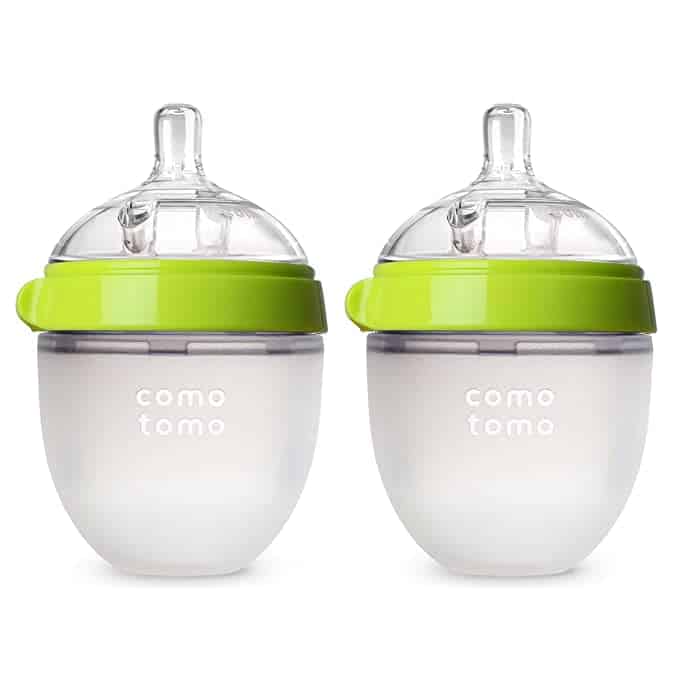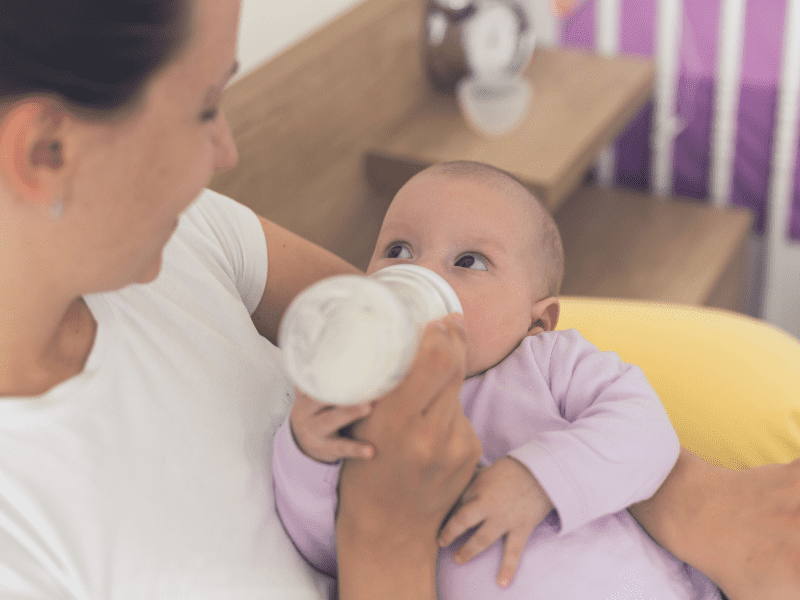How to Wean and Transition Your Breastfed Baby to a Bottle
There may come a time when you need to wean or transition your breastfed baby to a bottle, and it’s not as easy as you may think. Breastfed babies are known for being picky and struggle to take a bottle. In fact, some breastfed babies will never take a bottle, but if you need to transition to one, you have to know how to increase the likelihood of success.
I had trouble getting my nursing babies to take a bottle, so I could go places and leave my infants at home. However, if you’re trying to transition for work purposes or health reasons, you have to figure out how to do it – and you can!
It starts with figuring out if you want to wean and transition entirely OR if you want to only give a bottle when you’re out of the home. Then, start making a plan and make sure you stockpile the patience because you will need it.
Pin this blog for later! ↓

Related: Real Mom Tip Series: 16 Best Pumping Tips
When to Transition Your Breastfed Baby to a Bottle

Most lactation experts recommend waiting until your baby is at least one month old before introducing a bottle to your breastfed baby. Breastfeeding needs to be well-established before introducing a bottle, or you risk nipple confusion. Some babies get confused when switching between breast and bottle.
Waiting gives your body time to establish an adequate milk supply, and your baby has to learn to master latching and all the breastfeeding mechanics. Introducing a bottle too early may decrease your milk supply, which is an issue if you don’t plan to use formula.
If you return to work, start bottle feeding at least two weeks before you start date. It’s impossible to know if your baby will accept a bottle easily or not, so give yourself time to be able to approach this with patience.
You might assume that switching is easy, but sucking milk from a bottle is different than breastfeeding. It requires different mouth and tongue movements, and it takes time for your baby to get used to the change.
When Should I Wean My Baby From Breast to Bottle?
You don’t have to wean your baby from the breast; some mothers nurse exclusively and never transition fully to bottles. However, if you decide that you want to wean your baby off the breast entirely and switch to formula, you might wonder when the ideal age to do so is.
There is no perfect age, especially if you face troubles with your supply or face mental health issues while nursing. However, the American Academy of Pediatrics recommends infants breastfeed for at least six months, so that is a good goal to make.
Picking a Bottle for a Breastfed Baby
Not all bottles are ideal for a breastfed baby. All bottle nipples aren’t the same since they come in various sizes and shapes. Some babies have preferences, and it may take some experimenting to find the ones that work best for your baby.
Ideally, you want to use an anti-colic bottle with vented nipples because it ensures less air reaches your baby’s belly. Less air means less gas and fewer belly aches for your baby.
You also want to ensure you don’t have bottle nipples that are too large for your baby. Breastfeeding has a slower flow than bottle feeding; most breastfed babies rarely go beyond the slowest or next step up nipples the entire time using bottles.

We tried the Comotomo Baby Bottles and had great success with them. These are soft, silicone bottles, and breastfeeding mothers rave about them. Another option is the Nanobebe Breastmilk Baby Bottle; it’s quite shape makes it easier to switch back and forth for babies.
How to Transition Your Breastfed Baby to a Bottle

The key to successful transition your breastfed baby to a bottle is doing so slowly and at the right timing. The reality is not all babies will easily take a bottle; they prefer their milk from the tap. Your baby may not love a bottle, but if you have to transition while you work, patience and consistency will help your baby over time.
Here are some tips to make the transition as smooth as possible.
Offer a Bottle After Your Baby Had a Regular Feeding
Offering a bottle to your breastfed baby who is starving and wants to nurse is a recipe for disaster. Instead, pick a time when your baby is relaxed and relatively full, so they will tolerate trying a bottle.
Give your baby a small amount of breast milk – half an ounce – to get your baby use to an artificial nipple.
Use Paced Feeding to Mimic Breastfeeding
Paced feeding or cue-based feeding is a way of feeding that best mimics breastfeeding. It requires a slow-flow nipple, and the bottle must be kept horizontal. Paced-feeding requires frequent pauses during the feeding, and you need to switch sides as you do during breastfeeding.
Once your baby shows signs of being full, stop feeding your baby. It’s easy for bottle feeding babies to overeat and not recognize their signs of fullness.
Make Sure Someone Else Offers the First Bottle
The goal of transitioning your breastfed baby to a bottle is for someone else to feed your baby. So, if you give your baby the first bottle, he may be confused, or he may decide he is only going to take the bottle from you.
That defeats the purpose.
Many babies find it less confusing for someone else to give the bottle, so ask your partner, your parent, or a friend to give your baby a bottle.
Take a Walk or Leave the House
Ideally, you should leave the house when offering a bottle. Babies smell their mothers, even from a distance, so he may decide that the tap is too close for this substitute.
Don’t Change Things Too Fast
Babies need time to get used to a bottle after nursing for awhile, so be sure to use the same nipple, bottle, and technique for a few feedings before trying something new. One refusal of a bottle doesn’t mean you have to change the brand
Be Patient and Consistent
Always be patient and give your baby plenty of time during this process of weaning and transitioning. If your baby cries and pushes the bottle away, comfort him and try again. If he refuses three times, let it go for some time.
Wait an hour or two then offer the bottle again when your baby is alert but not frantically hungry.
Be Slow if Weaning
If you’re weaning your baby entirely to formula, take your time. Your breasts will go through some changes, and if you do this too fast, you’ll be engorged and miserable. Decrease a feeding at a time and give it a few days in between. You also can try to mix bottles with half formula and half breast milk to give your baby’s belly time to adjust.
What to Do If Your Breastfed Baby Resists a Bottle

The truth is that many breastfed babies refuse to take bottle; it’s not abnormal. I experienced this with my babies, and while I always hoped my babies would take a bottle without a fuss, that wasn’t what always happened.
However, there are some tips you can try to encourage your baby to accept a bottle. He may not love the bottle, but the hope is he at least tolerates it.
Try a Bottle Nipple Similar to The Pacifiers
If your baby takes a pacifier, then use a bottle nipple similar in shape. Most pacifier brands sell bottles as well, and consider if your baby prefers a latex or silicone nipple. This may help convince your baby that the bottle is not his enemy.
Put Breast Milk on the Bottle Nipple
Once the milk is on the bottle’s nipple, it may encourage your baby to start sucking to get more. However, don’t use honey or sugar; breast milk is enough to encourage most babies!
Try a Different Position
Sometimes, all it takes is a different position. While you may want to hold your baby in the normal breastfeeding position, that may frustrate your baby as he anticipates breastfeeding rather than the bottle.
Try putting your baby in a semi-upright position, such as in a car seat or on your lap with her back to your chest. After your baby adjusts to taking a bottle, you can try switching to different positions, but this goal is to make transitioning as easy as possible.
Try Different Milk Temperatures
Here is another thing babies become picky over. Your baby may prefer milk warmer than you offer or colder; some babies love cold milk! Experiment with different temperatures to see which one he prefers.
Also, some babies notice a difference between fresh milk and frozen milk. Some women have different lipase levels, resulting in a strange flavor after unthawing the milk. It may cause a metallic taste that your baby refuses.
Offer the Bottle at Different Times of the Day
If your baby isn’t a huge fan of taking a bottle at the start of the day, consider offering at nighttime or before nap time. While the goal may be to get your baby to take a bottle whenever, you have to start small and expand.
Why Did My Baby Take a Bottle Then Decide to Only Breastfeed?
Babies are quirky, so at times, an early success isn’t as amazing as you think. It’s not a guarantee that smooth sailing is always ahead, and your baby may decide not to take a bottle later.
Many babies take a bottle at first then suddenly decide they prefer only breastfeeding, and the bottle is for the birds. Breastfeeding is more than just nourishment; it’s comforting, warm, cozy, and involves mom – their favorite human in the whole world.
For most babies, this sudden refusal is a short development. With consistency, most babies will decide to take a bottle again soon.
What Do I Do if My Baby Refuses the Bottle Entirely?
At times, babies will refuse to take a bottle entirely, no matter what tips and tricks you try. Some breastfed babies will never take a bottle, even if you did everything “right.”
Others may say to wait it out because babies will take a bottle when they’re hungry enough, but this isn’t always true. Also, making babies go long stretches without eating is not good for them; this shouldn’t be a battle for you.
If all else fails, go to the cup route. Hold your baby upright in one arm and bring a cup to his mouth, tilting some milk into his mouth. He may lap it up but he will swallow. Some use medicine spoons for little babies or syringes.
Giving a breastfed baby a bottle may take a bit of patience and convincing, but it’s worth the effort






